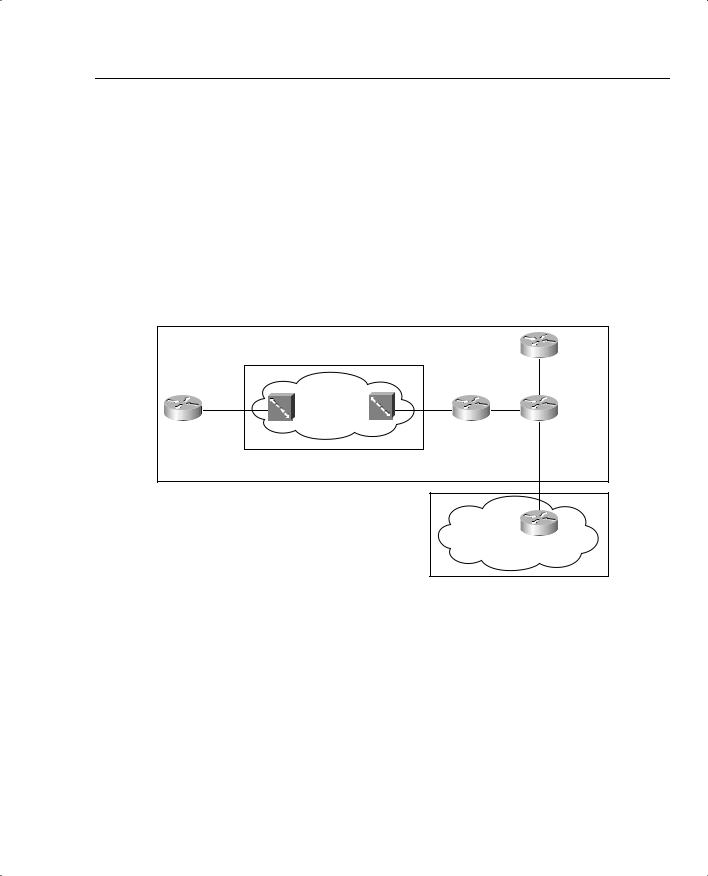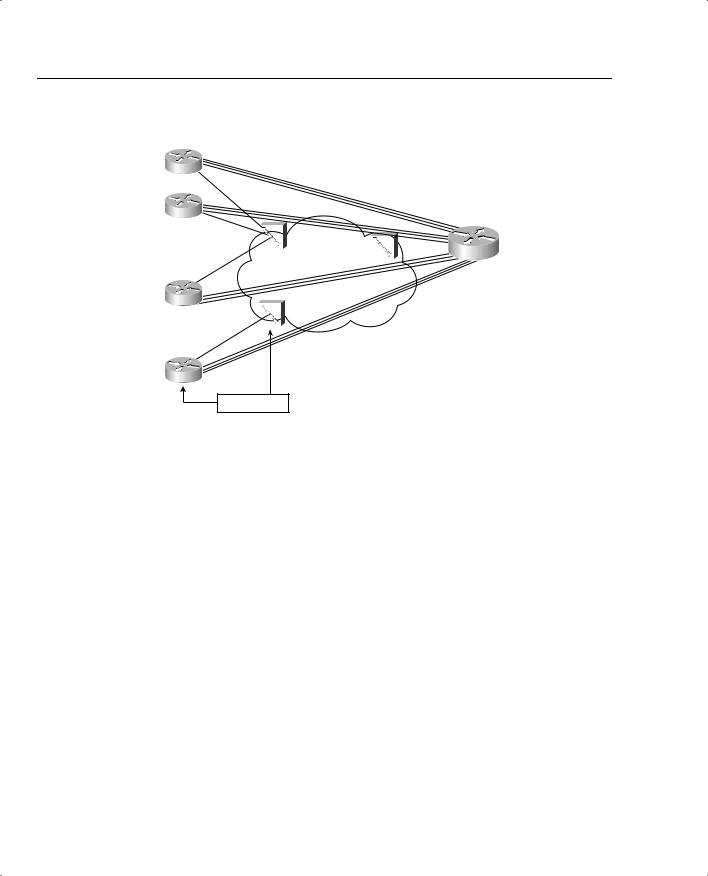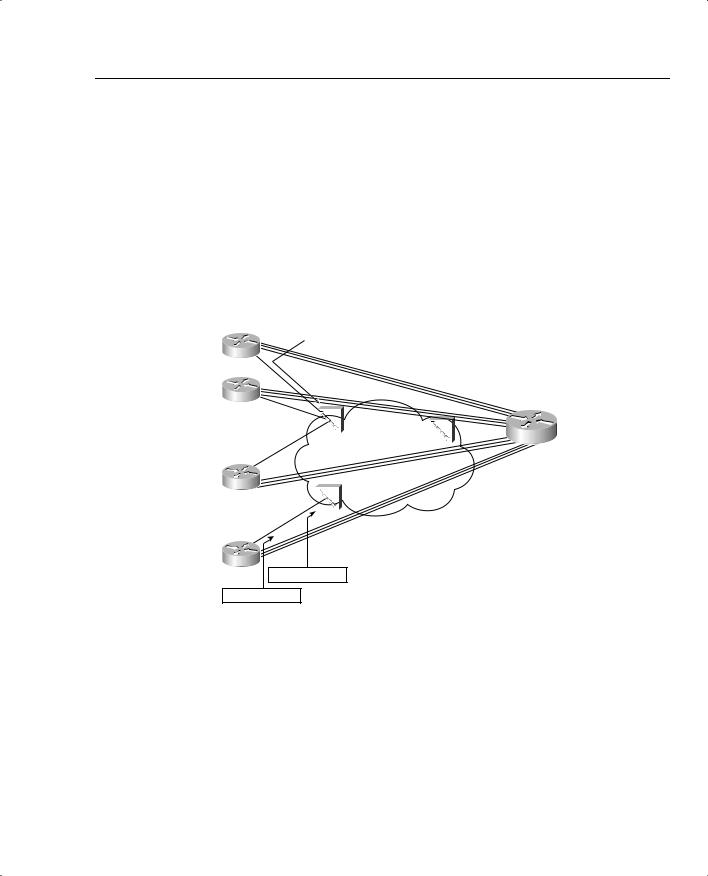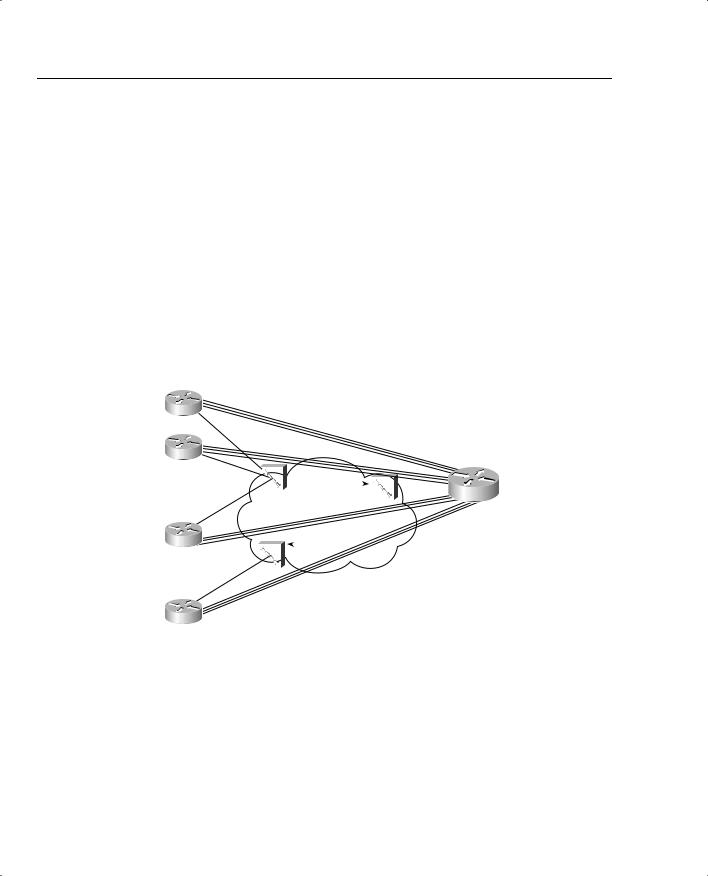
- •QoS Overview
- •“Do I Know This Already?” Quiz
- •QoS: Tuning Bandwidth, Delay, Jitter, and Loss Questions
- •Foundation Topics
- •QoS: Tuning Bandwidth, Delay, Jitter, and Loss
- •Bandwidth
- •The clock rate Command Versus the bandwidth Command
- •QoS Tools That Affect Bandwidth
- •Delay
- •Serialization Delay
- •Propagation Delay
- •Queuing Delay
- •Forwarding Delay
- •Shaping Delay
- •Network Delay
- •Delay Summary
- •QoS Tools That Affect Delay
- •Jitter
- •QoS Tools That Affect Jitter
- •Loss
- •QoS Tools That Affect Loss
- •Summary: QoS Characteristics: Bandwidth, Delay, Jitter, and Loss
- •Voice Basics
- •Voice Bandwidth Considerations
- •Voice Delay Considerations
- •Voice Jitter Considerations
- •Voice Loss Considerations
- •Video Basics
- •Video Bandwidth Considerations
- •Video Delay Considerations
- •Video Jitter Considerations
- •Video Loss Considerations
- •Comparing Voice and Video: Summary
- •IP Data Basics
- •Data Bandwidth Considerations
- •Data Delay Considerations
- •Data Jitter Considerations
- •Data Loss Considerations
- •Comparing Voice, Video, and Data: Summary
- •Foundation Summary
- •QoS Tools and Architectures
- •“Do I Know This Already?” Quiz
- •QoS Tools Questions
- •Differentiated Services Questions
- •Integrated Services Questions
- •Foundation Topics
- •Introduction to IOS QoS Tools
- •Queuing
- •Queuing Tools
- •Shaping and Policing
- •Shaping and Policing Tools
- •Congestion Avoidance
- •Congestion-Avoidance Tools
- •Call Admission Control and RSVP
- •CAC Tools
- •Management Tools
- •Summary
- •The Good-Old Common Sense QoS Model
- •GOCS Flow-Based QoS
- •GOCS Class-Based QoS
- •The Differentiated Services QoS Model
- •DiffServ Per-Hop Behaviors
- •The Class Selector PHB and DSCP Values
- •The Assured Forwarding PHB and DSCP Values
- •The Expedited Forwarding PHB and DSCP Values
- •The Integrated Services QoS Model
- •Foundation Summary
- •“Do I Know This Already?” Quiz Questions
- •CAR, PBR, and CB Marking Questions
- •Foundation Topics
- •Marking
- •IP Header QoS Fields: Precedence and DSCP
- •LAN Class of Service (CoS)
- •Other Marking Fields
- •Summary of Marking Fields
- •Class-Based Marking (CB Marking)
- •Network-Based Application Recognition (NBAR)
- •CB Marking show Commands
- •CB Marking Summary
- •Committed Access Rate (CAR)
- •CAR Marking Summary
- •Policy-Based Routing (PBR)
- •PBR Marking Summary
- •VoIP Dial Peer
- •VoIP Dial-Peer Summary
- •Foundation Summary
- •Congestion Management
- •“Do I Know This Already?” Quiz
- •Queuing Concepts Questions
- •WFQ and IP RTP Priority Questions
- •CBWFQ and LLQ Questions
- •Comparing Queuing Options Questions
- •Foundation Topics
- •Queuing Concepts
- •Output Queues, TX Rings, and TX Queues
- •Queuing on Interfaces Versus Subinterfaces and Virtual Circuits (VCs)
- •Summary of Queuing Concepts
- •Queuing Tools
- •FIFO Queuing
- •Priority Queuing
- •Custom Queuing
- •Weighted Fair Queuing (WFQ)
- •WFQ Scheduler: The Net Effect
- •WFQ Scheduling: The Process
- •WFQ Drop Policy, Number of Queues, and Queue Lengths
- •WFQ Summary
- •Class-Based WFQ (CBWFQ)
- •CBWFQ Summary
- •Low Latency Queuing (LLQ)
- •LLQ with More Than One Priority Queue
- •IP RTP Priority
- •Summary of Queuing Tool Features
- •Foundation Summary
- •Conceptual Questions
- •Priority Queuing and Custom Queuing
- •CBWFQ, LLQ, IP RTP Priority
- •Comparing Queuing Tool Options
- •“Do I Know This Already?” Quiz
- •Shaping and Policing Concepts Questions
- •Policing with CAR and CB Policer Questions
- •Shaping with FRTS, GTS, DTS, and CB Shaping
- •Foundation Topics
- •When and Where to Use Shaping and Policing
- •How Shaping Works
- •Where to Shape: Interfaces, Subinterfaces, and VCs
- •How Policing Works
- •CAR Internals
- •CB Policing Internals
- •Policing, but Not Discarding
- •Foundation Summary
- •Shaping and Policing Concepts
- •“Do I Know This Already?” Quiz
- •Congestion-Avoidance Concepts and RED Questions
- •WRED Questions
- •FRED Questions
- •Foundation Topics
- •TCP and UDP Reactions to Packet Loss
- •Tail Drop, Global Synchronization, and TCP Starvation
- •Random Early Detection (RED)
- •Weighted RED (WRED)
- •How WRED Weights Packets
- •WRED and Queuing
- •WRED Summary
- •Flow-Based WRED (FRED)
- •Foundation Summary
- •Congestion-Avoidance Concepts and Random Early Detection (RED)
- •Weighted RED (WRED)
- •Flow-Based WRED (FRED)
- •“Do I Know This Already?” Quiz
- •Compression Questions
- •Link Fragmentation and Interleave Questions
- •Foundation Topics
- •Payload and Header Compression
- •Payload Compression
- •Header Compression
- •Link Fragmentation and Interleaving
- •Multilink PPP LFI
- •Maximum Serialization Delay and Optimum Fragment Sizes
- •Frame Relay LFI Using FRF.12
- •Choosing Fragment Sizes for Frame Relay
- •Fragmentation with More Than One VC on a Single Access Link
- •FRF.11-C and FRF.12 Comparison
- •Foundation Summary
- •Compression Tools
- •LFI Tools
- •“Do I Know This Already?” Quiz
- •Foundation Topics
- •Call Admission Control Overview
- •Call Rerouting Alternatives
- •Bandwidth Engineering
- •CAC Mechanisms
- •CAC Mechanism Evaluation Criteria
- •Local Voice CAC
- •Physical DS0 Limitation
- •Max-Connections
- •Voice over Frame Relay—Voice Bandwidth
- •Trunk Conditioning
- •Local Voice Busyout
- •Measurement-Based Voice CAC
- •Service Assurance Agents
- •SAA Probes Versus Pings
- •SAA Service
- •Calculated Planning Impairment Factor
- •Advanced Voice Busyout
- •PSTN Fallback
- •SAA Probes Used for PSTN Fallback
- •IP Destination Caching
- •SAA Probe Format
- •PSTN Fallback Scalability
- •PSTN Fallback Summary
- •Resource-Based CAC
- •Resource Availability Indication
- •Gateway Calculation of Resources
- •RAI in Service Provider Networks
- •RAI in Enterprise Networks
- •RAI Operation
- •RAI Platform Support
- •Cisco CallManager Resource-Based CAC
- •Location-Based CAC Operation
- •Locations and Regions
- •Calculation of Resources
- •Automatic Alternate Routing
- •Location-Based CAC Summary
- •Gatekeeper Zone Bandwidth
- •Gatekeeper Zone Bandwidth Operation
- •Single-Zone Topology
- •Multizone Topology
- •Zone-per-Gateway Design
- •Gatekeeper in CallManager Networks
- •Zone Bandwidth Calculation
- •Gatekeeper Zone Bandwidth Summary
- •Integrated Services / Resource Reservation Protocol
- •RSVP Levels of Service
- •RSVP Operation
- •RSVP/H.323 Synchronization
- •Bandwidth per Codec
- •Subnet Bandwidth Management
- •Monitoring and Troubleshooting RSVP
- •RSVP CAC Summary
- •Foundation Summary
- •Call Admission Control Concepts
- •Local-Based CAC
- •Measurement-Based CAC
- •Resources-Based CAC
- •“Do I Know This Already?” Quiz
- •QoS Management Tools Questions
- •QoS Design Questions
- •Foundation Topics
- •QoS Management Tools
- •QoS Device Manager
- •QoS Policy Manager
- •Service Assurance Agent
- •Internetwork Performance Monitor
- •Service Management Solution
- •QoS Management Tool Summary
- •QoS Design for the Cisco QoS Exams
- •Four-Step QoS Design Process
- •Step 1: Determine Customer Priorities/QoS Policy
- •Step 2: Characterize the Network
- •Step 3: Implement the Policy
- •Step 4: Monitor the Network
- •QoS Design Guidelines for Voice and Video
- •Voice and Video: Bandwidth, Delay, Jitter, and Loss Requirements
- •Voice and Video QoS Design Recommendations
- •Foundation Summary
- •QoS Management
- •QoS Design
- •“Do I Know This Already?” Quiz
- •Foundation Topics
- •The Need for QoS on the LAN
- •Layer 2 Queues
- •Drop Thresholds
- •Trust Boundries
- •Cisco Catalyst Switch QoS Features
- •Catalyst 6500 QoS Features
- •Supervisor and Switching Engine
- •Policy Feature Card
- •Ethernet Interfaces
- •QoS Flow on the Catalyst 6500
- •Ingress Queue Scheduling
- •Layer 2 Switching Engine QoS Frame Flow
- •Layer 3 Switching Engine QoS Packet Flow
- •Egress Queue Scheduling
- •Catalyst 6500 QoS Summary
- •Cisco Catalyst 4500/4000 QoS Features
- •Supervisor Engine I and II
- •Supervisor Engine III and IV
- •Cisco Catalyst 3550 QoS Features
- •Cisco Catalyst 3524 QoS Features
- •CoS-to-Egress Queue Mapping for the Catalyst OS Switch
- •Layer-2-to-Layer 3 Mapping
- •Connecting a Catalyst OS Switch to WAN Segments
- •Displaying QoS Settings for the Catalyst OS Switch
- •Enabling QoS for the Catalyst IOS Switch
- •Enabling Priority Queuing for the Catalyst IOS Switch
- •CoS-to-Egress Queue Mapping for the Catalyst IOS Switch
- •Layer 2-to-Layer 3 Mapping
- •Connecting a Catalyst IOS Switch to Distribution Switches or WAN Segments
- •Displaying QoS Settings for the Catalyst IOS Switch
- •Foundation Summary
- •LAN QoS Concepts
- •Catalyst 6500 Series of Switches
- •Catalyst 4500/4000 Series of Switches
- •Catalyst 3550/3524 Series of Switches
- •QoS: Tuning Bandwidth, Delay, Jitter, and Loss
- •QoS Tools
- •Differentiated Services
- •Integrated Services
- •CAR, PBR, and CB Marking
- •Queuing Concepts
- •WFQ and IP RTP Priority
- •CBWFQ and LLQ
- •Comparing Queuing Options
- •Conceptual Questions
- •Priority Queuing and Custom Queuing
- •CBWFQ, LLQ, IP RTP Priority
- •Comparing Queuing Tool Options
- •Shaping and Policing Concepts
- •Policing with CAR and CB Policer
- •Shaping with FRTS, GTS, DTS, and CB Shaping
- •Shaping and Policing Concepts
- •Congestion-Avoidance Concepts and RED
- •WRED
- •FRED
- •Congestion-Avoidance Concepts and Random Early Detection (RED)
- •Weighted RED (WRED)
- •Flow-Based WRED (FRED)
- •Compression
- •Link Fragmentation and Interleave
- •Compression Tools
- •LFI Tools
- •Call Admission Control Concepts
- •Local-Based CAC
- •Measurement-Based CAC
- •Resources-Based CAC
- •QoS Management Tools
- •QoS Design
- •QoS Management
- •QoS Design
- •LAN QoS Concepts
- •Catalyst 6500 Series of Switches
- •Catalyst 4500/4000 Series of Switches
- •Catalyst 3550/3524 Series of Switches
- •Foundation Topics
- •QPPB Route Marking: Step 1
- •QPPB Per-Packet Marking: Step 2
- •QPPB: The Hidden Details
- •QPPB Summary
- •Flow-Based dWFQ
- •ToS-Based dWFQ
- •Distributed QoS Group–Based WFQ
- •Summary: dWFQ Options

Traffic-Policing and Traffic-Shaping Concepts 323
shaping and policing use similar mechanisms to account for the numbers of bits and bytes sent over time. First, however, we start with the motivations for using shaping and policing.
When and Where to Use Shaping and Policing
Most implementations of shaping and policing occur at the edges between two different networks. For instance, consider Figure 5-1, which illustrates the two typical cases for shaping and policing. The figure shows PB Tents Enterprise network, with a Frame Relay service, and Internet connectivity using ISP1.
Figure 5-1 Connection to an ISP, and to a Frame Relay Network
PB Tents Enterprise Network
Frame Relay Network |
R4 |
|
|
||
Link1 |
Link2 |
|
AR 128 kbps |
AR 1.544 Mbps |
|
R1 |
R2 |
R3 |
FRS1 |
FRS2 |
|
|
|
Link3 |
|
|
FastE |
|
|
2 Mbps CIR |
|
|
ISP-R1 |
|
ISP |
|
In this case, PB Tents has three separate boundaries between different networks. Link1, between R1 and the Frame Relay network switch labeled FRS1, is the first boundary. The second boundary is between the switch FRS2 and R2. Finally, a boundary exists between R3 and ISP-R1, over Link3.
For each boundary, the legal documents that detail the agreement between PB Tents and the Frame Relay service provider, and the documents that detail the agreement with ISP1, include something called a traffic contract. The need for the contract makes the most sense in the context of Frame Relay, but it also applies to the Internet connection. For instance, R2 uses a T/1 access link into the Frame Relay network. However, the virtual circuit (VC) between R2 and R1 may only include a committed information rate (CIR) of 64 kbps. Similarly, R1 has a 128-kbps access link, and the CIR of the VC to R2 still has a CIR of 64 kbps. When R1 sends

324 Chapter 5: Traffic Policing and Shaping
a packet, the packet is transmitted at 128 kbps—that’s the only speed that physically works! Likewise, R2 must send at 1.5 Mbps. However, the traffic contract may just state that the VC from R1 to R2 allows only 64 kbps in each direction.
Similarly, PB Tents and ISP1 may agree to install a link that is faster than PB Tents actually needs right now, expecting that PB Tent’s Internet traffic loads will grow. When PB Tents needs more capacity to the Internet, each party can just agree to a new traffic contract, and PB Tents will pay ISP1 more money. For instance, metro Ethernet/Fast Ethernet/Gigabit Ethernet services have become more common; most sites do not really need 100 Mbps of bandwidth to the Internet. If PB Tents connected to ISP1 using a Fast Ethernet connection, but the traffic contract stated that PB Tents gets only 2 Mbps of service, however, the same mismatch between physical capability and legal ability, as seen with Frame Relay, occurs on the Internet connection.
In short, policing and shaping can play a role in cases where a router can send more traffic than the traffic contract allows. Shaping just slows the rate of sending packets so that the traffic contract is not exceeded. Policing discards some packets so that the traffic contract is not exceeded.
Policing— When and Where?
Whenever the physical clock rate exceeds the traffic contract, policing may be needed. Suppose, for instance, that ISP1 has 1000 customers, just like PB Tents, each with a 100-Mbps connection, and a contract for support of 2 Mbps. What happens over time? Well, without something to prevent it, each customer will send and receive more and more traffic. For a while, all the customers are happy, because their packets make it through the overbuilt ISP1 core. Even if ISP1 has enough capacity to support 10 Mbps of traffic from every customer, eventually, ISP1’s network will become overrun, because their customers keep sending more and more traffic, so eventually all traffic will suffer. Queues become congested frequently, causing dropped packets. Multimedia traffic suffers through the poor performance as a result of high delay and jitter. TCP sessions continually decrease their window sizes because of the lost packets, causing synchronization effects inside ISP1. ISP1 can add capacity, but that probably means that ISP1 should start charging more to their customers, who may not be willing to upgrade to a higher-traffic contract.
In actual ISP networks, the network engineers design the core of the network expecting some degree of oversubscription. The term “oversubscription” means that the customer has sent and received more traffic than was contracted, or subscribed. As in the example of ISP1 in the preceding paragraph, ISPs and Frame Relay providers build their network expecting some oversubscription. However, they certainly do not build the core expecting every customer to send traffic at full access rate, all the time.
Policing protects a network from being overrun by traffic. If ISP1 just policed traffic from each customer, discarding packets that exceed the traffic contract, it would protect itself from being overrun. However, the decision to add policing to a network can be politically difficult. Suppose that ISP1 has these 1000 customers, each of whom contracted for 2 Mbps of traffic. Each

Traffic-Policing and Traffic-Shaping Concepts 325
customer sends and receives more, averaging 10 Mbps, so that ISP1’s network is becoming too congested. ISP1 chooses to implement policing, using the contracted rate, discarding packets that exceed 2 Mbps of traffic. Of course, most of their customers will be very unhappy! Such a move may be a career-ending, if not business-ending, choice.
Policers can also just mark down the traffic, instead of discarding it. To do so, the policer marks the packet with a different IP precedence or DSCP value when the traffic rate is exceeded, but it still lets the packet through. Later QoS functions, including policers and packet-drop tools such as Weighted Random Early Detection (WRED), can more aggressively discard markeddown packets as compared with those that have not been marked down. Essentially, the policer can increase the chance that a packet will get discarded somewhere else in the network if that packet causes the traffic rate to be exceeded. Generally speaking, when policers mark down packets, if the network is not currently congested, the packet can get through the network; if congested, the packet is much more likely to be discarded.
ISPs make the business choice of whether to police, and how aggressively to police. The options reduce to the following three basic options:
•Do not police. To support the traffic, build the network to support the traffic as if all customers will send and receive data at the clock rate of the access link. From a sales perspective, close deals by claiming that no policing will be done, but encourage customers who exceed their contracts to pay for more bandwidth.
•Police at the contracted rate. To support these traffic levels, the network only needs to be built to support the collective contracted rates, although the core would be overbuilt to support new customers. From a sales perspective, encourage customers that are beginning to exceed their contracts to upgrade, and give incentives.
•Police somewhere in between the contracted rate and the access-link clock rate. For instance, ISP1 might police PB Tents at 5 Mbps, when the contract reads 2 Mbps. The network can be built to support the collective policed rates. The sales team can encourage customers to buy a larger contracted rate when they consistently exceed the contracted rate, but keep customer satisfaction higher by pointing out their generosity by only policing at rates much higher than the contracted rates.
Policing can be useful in multiaccess WANs (Frame Relay and ATM networks) for the same reason that it was useful for the ISP connection described earlier. Whenever data can be sent faster than the contracted rate, the danger exists that a network will be overrun when many sites exceed their contract at the same time. An example will help you understand a few of the issues. Figure 5-2, the network diagram for PB Tents network, has been expanded to show 12 branches, with a single central site.

326 Chapter 5: Traffic Policing and Shaping
Figure 5-2 PB Tents Network, 12 Frame Relay Branches, 1 Central Site
R1 |
|
|
|
|
|
|
|
AR 128 kbps |
|
|
|
|
|||
R2 |
|
|
|
All VCs 64 kbps CIR |
|
|
|
AR 128 kbps |
|
|
|
|
|
|
Main |
|
|
|
|
|
|
||
|
|
|
|
|
|
|
|
AR 128 kbps |
FRS1 |
FRS2 |
|
AR 1.5 Mbps |
|||
|
|
||||||
|
|
||||||
.R3 |
|
|
|
FRS3 |
|
|
|
|
|
|
|
|
|||
. AR 128 kbps |
|
|
|
|
|
|
|
|
|
|
|
|
|
|
|
. |
|
|
|
|
|
|
|
R12
Policing to X kbps
Each branch can send traffic at 128 kbps, but each branch only has a contracted 64-kbps CIR on their respective VCs to the main site. If all 12 sites conform to their CIRs, the Frame Relay network should be able to handle the load. If all 12 sites offer 128 kbps of traffic for long periods, however, the provider may still go ahead and try to forward all the traffic, because most Frame Relay providers overbuild their core networks. They also like to imply in their sales pitch that the customer gets to send excess packets for free.
Of course, at some point, if every customer of this provider sent traffic at full line rates for a period of time, the network would probably congest. The same options exist for the Frame Relay network as for an ISP—not to police but build more capacity; police to CIR, and deal with the sales and customer satisfaction issues; or police at something over CIR, and deal with the sales and customer satisfaction issues in slightly different ways.
To police the network in Figure 5-2, the Frame Relay switches can be configured to perform the policing, or the routers can be used. Traditionally, policing is performed as packets enter a network, which would suggest policing as packets enter the Frame Relay switches from the customer. If the service provider actually controls the edge routers in the enterprise network, however, the policing feature can be performed as packets exit the routers, going toward the Frame Relay cloud. If the customer controls the routers at the edge of the cloud, policing in these routers may be risky for the service provider, just because of the possibility that some customers might turn off policing to get more capacity for free.
The Cisco QoS exams cover policing in IOS routers. The exams do not cover policing in Frame Relay switches, or in LAN switches, although the basic concepts are the same.

Traffic-Policing and Traffic-Shaping Concepts 327
Traffic Shaping— When and Where?
Networks use traffic shaping for two main reasons:
•To shape the traffic at the same rate as policing (if the service provider polices traffic)
•To avoid the effects of egress blocking
For instance, consider Branches 1 and 24 in Figure 5-3. Branch 1 does not shape, whereas Branch 24 does shape to 96 kbps. In both cases, the Frame Relay switches they are connected to police packets at a 96-kbps rate. (The CIR in each case is 64 kbps. Therefore, the service provider is not policing aggressively. The PB Tents engineer wants to get as much bandwidth as possible out of the service, so he shapes at 96 kbps rather than the 64-kbps CIR.)
Figure 5-3 PB Tents Network, Policing and Shaping, Versus Just Policing
|
|
Policing to 96 kbps |
|
|
|
||||
R1 |
|
|
|
|
|
|
|
|
|
AR 128 kbps |
|
|
|
|
|
||||
|
|
|
|
|
|
||||
R2 |
|
|
|
|
All VCs 64 kbps CIR |
|
|
||
AR 128 kbps |
|
|
|
|
|
|
|
|
Main |
|
|
|
|
|
|
|
|
||
|
|
|
|
|
|
|
|
|
|
AR 128 kbps |
|
|
FRS1 |
|
FRS2 |
|
AR 1.5 Mbps |
||
|
|
|
|
|
|||||
|
|
||||||||
.R3 |
|
|
|
|
FRS3 |
|
|
||
|
|
|
|
|
|
||||
. AR 128 kbps |
|
|
|
|
|
|
|
|
|
|
|
|
|
|
|
|
|
|
|
. |
|
|
|
|
|
|
|
|
|
R24
Policing to 96 kbps
Shaping to 96 kbps
For Branch 1, the absence of shaping ensures that R1 will not artificially delay any packets. However, the policing performed at FRS1 will discard some packets when R1 sends more than 96-kbps worth of traffic. Therefore, some packets will be dropped, although the packets that are not dropped will not experience extra shaping delay. This strategy makes sense when the traffic from Branch 1 is not drop sensitive, but may be delay and jitter sensitive.
For Branch 24, the presence of shaping ensures that R1 will artificially delay some packets. However, the policing performed at FRS3 will not discard packets, because R1 will not send more than 96-kbps worth of traffic. Therefore, no packets will be dropped, although some packets will experience more delay and jitter. This strategy makes sense when the traffic from Branch 24 is drop sensitive, but not delay and jitter sensitive.

328 Chapter 5: Traffic Policing and Shaping
The other reason to use shaping is to avoid the effects of egress blocking. Egress blocking occurs when packets try to exit a multiaccess WAN, such as Frame Relay and ATM, and cannot exit the network because of congestion. Automobile traffic patterns cause the same kinds of behavior as egress blocking. In the morning, for instance, everyone in the state may try to commute to the same small, downtown area of a big city. Even though an eight-lane highway leads into the city, it may seem that everyone living in the surrounding little towns tries to get off at the few exits of the highway between 7 and 8 a.m. each morning. The highway and exits in the downtown area become congested. Similarly, in the afternoon, if everyone tries to reach the suburbs through one exit off the highway at 5:30 p.m., the eight-lane highway feeding into the two-lane exit road becomes congested. Likewise, although plenty of capacity may exist in a network, egress blocking can occur for packets trying to exit the network.
Figure 5-4 illustrates what happens with egress blocking, using a Frame Relay network as an example.
Figure 5-4 PB Tents Network, Egress Blocking
|
|
|
|
|
|
All VCs 64 kbps CIR |
|
|
|
|||||
|
|
|
|
Cumulative Traffic Can Be |
|
|
|
|
||||||
R1 |
|
|
|
24 * 128 kbps = 3.0 Mbps |
|
|
|
|
||||||
AR 128 kbps |
|
|
|
|
|
|
|
|
|
|
||||
R2 |
|
|
|
|
|
|
|
|
|
|
|
|
|
|
AR 128 kbps |
|
|
|
|
|
|
|
|
|
|
|
|
|
Main |
|
|
|
|
|
|
|
|
|
|
|
|
|
||
|
|
|
|
|
|
|
|
|
|
|
|
|
|
|
|
|
|
|
|
|
|
|
|
|
|
|
|
|
|
AR 128 kbps |
|
FRS1 |
|
|
FRS2 |
|
|
AR 1.5 Mbps |
||||||
|
|
|
|
|
|
|
||||||||
|
|
|
|
|||||||||||
.R3 |
|
|
|
|
|
|
|
|
|
|
|
|
|
|
|
|
|
|
FRS3 |
|
|
|
|
|
|
|
|||
. AR 128 kbps |
|
|
|
|
|
|
|
|
|
|
|
|
|
|
|
|
|
|
|
|
|
|
|
|
|
|
|
|
|
. |
|
|
|
|
|
|
|
|
|
|
|
|
|
|
|
|
|
|
|
|
|
|
|
|
|||||
R24 |
Speed Mismatch Between Main (1.5 Mbps) |
|
|
|||||||||||
and R24 Access Rate (128 kbps) Causes Blocking |
|
|
||||||||||||
|
|
|
||||||||||||
|
|
|
|
|
|
|
|
|
|
|
|
|
|
|
Suppose that all 24 branches shape at 64 kbps. The cumulative traffic sent by the branches to the main site is 1.5 Mbps, if each branch simultaneously sends 64 kbps. Because the Main router has a T/1 installed, FRS2 should not experience congestion when forwarding packets out of the access link to the Main router. However, what if shaping were not used at the branches? If all 24 branches were to send traffic at 128 kbps (access rate) for a period of time, the cumulative offered load would be about 3 Mbps. Packets would begin to queue trying to exit FRS2’s interface connected to the Main router. The packets would experience more delay, more jitter,

Traffic-Policing and Traffic-Shaping Concepts 329
and eventually more packet drops as the FRS2 output queue filled. Notice that the service provider did not do any policing—egress blocking still occurred, because the branches could collectively overload the egress link between the cloud and the main site.
Interestingly, even if policing were used, and shaping at the branches, egress blocking could still occur. In Figure 5-3, shaping and policing were configured at 96 kbps, because the service provider did not want to be too aggressive in enforcing the traffic contract. With all 24 branches sending 96 kbps at the same time, about 2.25 Mbps of traffic needs to exit FRS2 to get to the Main router. Again, egress blocking can occur, even with policing and shaping enabled!
Similarly, egress blocking can occur right to left in the figure as well. Imagine that the Main router receives 11 consecutive 1500-byte packets from a LAN interface, destined to Branch 24. It takes the Main router roughly 100 milliseconds to send the packets into the Frame Relay network, because its access link is a T/1. When the frames arrive in FRS1, they need to be sent out the access link to R24. However, this access link runs at 128 kbps. To send these 11 packets, it takes slightly more than 1 second just to serialize the packets over the link! Most of the packets then wait in the output queue on FRS3, waiting their turn to be sent. This simple case is another example of egress blocking, sometimes just referred to as a speed mismatch.
One solution to the egress blocking problem is to shape the traffic. In the example network, shaping all VCs at the branches to 64 kbps would ensure that the cumulative offered load did not exceed the access rate at the main site. Similarly, if the Main router shaped the VC to R1 to 64 kbps, or even 128 kbps, the egress blocking problem on FRS1 would be solved.
In both cases, however, delay and jitter occurs as a result of the shaping function. Instead of having more queuing delay in the Frame Relay switches, shaping delays occur in the router because packets wait in router output queues. With the queuing occurring in the routers, however, the features of IOS queuing tools can be used to better manipulate the traffic, and give better delay characteristics to delay-sensitive traffic. For instance, with the queues forming in a router, the router can use Low Latency Queuing (LLQ) to dequeue Voice over IP (VoIP) packets first. A Frame Relay switch cannot perform complicated queuing, because the Frame Relay switch does not examine fields outside the Frame Relay or IP header when making forwarding and queuing decisions.
Table 5-2 summarizes some of the key points about the rationale behind when you should use policing and shaping.
Table 5-2 Policing and Shaping: When to Use Them, and Where
Topic |
Rationale |
|
|
Why police? |
If a neighboring network can send more traffic than the traffic contract specifies, |
|
policing can be used to enforce the contract, protecting the network from being |
|
overrun with too much traffic. |
|
|
Where to police? |
Typically, policing is performed as packets enter the first device in a network. |
|
Egress policing is also supported, although it is less typical. |
|
|
continues
